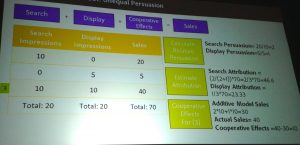There is a lot of buzz around attribution. In this session, Sid Shah from Adobe spoke about the following topics as it relates to Attribution and your Media Mix by looking at the following three items:
- Choose the right model
- Attribution does not equal Media Mix
- Media mix models should be realistic and predictive
For attribution, you can’t rely on the Last Click. 49% of conversions happen after multiple clicks so you must analyze the entire path to be predictive. There are many different Heuristic Attribution Models:
- Last Click
- First Click
- Equal
- Last More
- First More
- Custom
Mathematically all these models are equally right an equally wrong.
Here are a couple complex models:
- Bottom’s Up Attribution – the theory here is you start with two different methods and see what converts. For example, you start with a search and display an impression and measure the conversions. Then you do the same without the impression and see what is the conversion rate. From here you can calculate probabilities of conversion based on the conversion paths. Unfortunately, this method is problematic when it comes to scaling up the testing.
- Shapley Top Down Attribution – Roy Shapley won a nobel prize for Game Theory.
 Here you start with a goal and see how each marketing/sales effort contributes to the response. Here you have to account for extraneous factors like weather, pricing, the economy and others that may affect the measures. So you want to see if you increase one marketing effort by 5%, how does that affect the conversion rate. If all channels and efforts contribute equally, then attribution is a simple redistribution of sales based on the fraction of impressions. But if there is unequal persuasion in the various channels, you can then find the attribution of each channel and develop probablities for the effect of a channel on the overall outcome.
Here you start with a goal and see how each marketing/sales effort contributes to the response. Here you have to account for extraneous factors like weather, pricing, the economy and others that may affect the measures. So you want to see if you increase one marketing effort by 5%, how does that affect the conversion rate. If all channels and efforts contribute equally, then attribution is a simple redistribution of sales based on the fraction of impressions. But if there is unequal persuasion in the various channels, you can then find the attribution of each channel and develop probablities for the effect of a channel on the overall outcome.
Note that attribution looks back in time and does not provide you a future view. This is where the Media Mix comes into play. Most marketing response usually follows a power-law model. However, the models can become complex very quickly because there are multiple marketing inputs, macro influences, and mutliple outcomes that have to be part of the model. Once you have a good model, you can then start to use the Shapley Attribution to gain insights with which to do Media Mix planning.
Sid presented a case study that showed several media channels where email and display were most effective at the point in time. After going through the attribution process to see where channels affected leads and revenue, we find that display is contributing more to leads and less to revenue. PR was attributed to a small impact on leads, but had a large impact on revenue. This data helps us see where we gained good outputs based on historical data. But Sid warns not to use this data for future planning.
Using the insights, we can optimize the market spend inflight on the media mix that contributes most to our goals. However the optimum mix may not be possible due to other constraints. In the example, the optimization process said to increase spend on PR by 70%. However the company could not hire enough PR people quick enough to make this optimization possible.
Adobe has a Market Mix Planner product that will help in the planning process.

But now, with the prevalence of social media accounts, caretakers must
now tackle the hurdle that is their loved one’s online presence.
Learning to do business online is just another skill that can be acquired
in the same way we acquire other skills. I mean, you can get
a commission check anywhere, and even of you don’t think this could happen; your
company could shut down in a heartbeat and leave you
stranded.